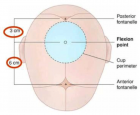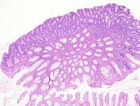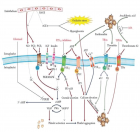Abstract
Research Article
Management of Chocolate Spot Disease in Faba Bean Plants by using Biological Control Means
Ahmed MFA*, Salem EA, Mahmoud MA and Shaheen SI
Published: 04 December, 2023 | Volume 7 - Issue 3 | Pages: 142-150
Background: Faba bean (Vicia faba L.) is one of the most important grain legume crops in Egypt and many other countries of the world because the seeds offer a low-cost source of protein, lysine, carbohydrates, minerals, and vitamins. Chocolate spot disease is a stress-related fungal disease produced by Botrytis fabae that causes plant damage, limits photosynthetic activity, and reduces yield.
Results: Trichoderma atroviride greatly reduced mycelial growth by 90.00% in vitro, followed by T. harzianum (86.67%) and T. album (83.89%) on average. In vivo, all studied antagonists dramatically reduced Botrytis fabae disease incidence and severity in both seasons 2021/22 and 2022/23. T. atroviride showed the highest efficacy bioagent (73.55 and 85.15%), followed by T. harzianum (72.55 and 81.22%), in controlling B. fabae of faba bean plants in both seasons. In addition, the results also showed that all tested biological treatments had an impact on yield components and increased levels of chlorophyll, protein%, phenols, flavonoids, Peroxidase (PO), polyphenol Oxidase (PPO), chitinase, and -1, 3-glucanase activities compared to control treatment in both seasons. In this regard, spraying T. atroviride showed the highest efficacy as a bioagent, followed by T. harzianum. Contrary, T. hamatum showed the lowest efficacy compared to other treatments in both seasons.
Conclusion: This investigation was carried out to determine the effectiveness of several different antagonists, i.e., T. album, T. atrovirde, T. hamatum, and T. harzianum (30 x 106 spore/ml), Blight Stop, and Bio Zeid, for controlling Botrytis fabae on bean plants and evaluating their effect on yield parameters, components, and quality.
Read Full Article HTML DOI: 10.29328/journal.jpsp.1001120 Cite this Article Read Full Article PDF
Keywords:
Biological control; Botrytis fabae; Faba bean
References
- Teshome E, Tagegn A. Integrated management of chocolate spot (Botiytis fabae) of faba bean (Vicia faba L.) at highlands of Bale, south eastern Ethiopia. Res J Agric Environ Manag. 2013; 2(1): 11-14.
- Sharawy ElNAM, Mahmoud MHM, Mehasen SA and Dyab AS. Technological Characteristics and Quality Attributes of Some Faba Bean (Vicia Faba ) Varieties. Annals of Agric. Sci. Moshtohor. 2022; 60(1): 73 - 84.
- Gomaa MA1, Ghareeb RYG, Abd El, Latif HAS, Kandil EE. Productivity of Some Faba Bean (Vica faba) Cultivars Under Different Planting Times. Egypt. Acad. Journal Biology. Sci. 2023; 14(1):105-111. DOI: 10.21608/eajbsh.2023.302851
- Dhull SB, Kidwai MK, Noor R, Chawla P and Rose PK. A review of nutritional profile and processing of faba bean (Vicia faba). Legume Science. 2021; 3 (129): 1-13. https://doi.org/ 10.1002/leg3.129.
- Annual Bulletin of the agricultural statistical. Winter field, Vegetable crops, Greenhouses year 2021/2022. Agriculture Directorates of Governorates, Economic Affairs Sector, Ministry of Agriculture and Land Reclamation, A.R.E. (in Arabic). 2022; 140.
- Abo-Hogazy SRE, El-Badawy NF, Mazen MM, Abd El-Menern H. Evaluation of some faba bean genotypes against chocolate spot disease using cDNA fragments of chitinase gene and some traditional methods. Asian J Agric Res. 2012; 6(2):60–72.
- Torres SAM, Roman B, Avila CM, Satovic Z, Rubials D, Sillero JC, Cubero JL, Moreno MT. Faba bean breeding for resistance against biotic stresses: Towards application of marker technology. Euphytica. 2004; 147: 67-80. DOI:1007/s10681-006-4057-6
- El-Banoby FE, Abd-AllA MA, Tolba IH, Morsy AA, El-Gamal NG, Khalil MSA. Biological control of chocolate spot disease of faba bean using some bioagents under field conditions. J Appl Sci Res. 2013; 9(6): 4021-4029.
- El-Kholy RMA. Chemical and biological control of chocolate spot disease in faba bean under field conditions. Middle East J Agric Res. 2014; 3(2): 368-377.
- El-Nagar TS, EL-Kot GA, Sarhan EAD, Maswada HF and Elzaawely AA. Effect of Frankincense on Controlling Chocolate Spot of Faba Bean. Egyptian Journal of Phytopathology. 2022; 50 (2): 151-159. DOI 10.21608/ejp.2022.179094.1078
- Abd El-Hai KM, El-Ghamry AM, Ghoneem KM. Induction of Faba bean resistance to Chocolate Spot and rust diseases and improving the productivity using amino and humic acids. Egypt. J. Phytopathol. 2011; 39(2): 43-58. DOI: 21608/ejp.2011.228686
- Metwaly HA. Control of chocolate spot disease by non-traditional methods on faba bean plants. Egypt. J. Phytopathol. 2014; 42(1): 143-158.
- Barakat FM, Abada KA, Abou-Zeid NM, El-Gammal YHE. Effect of volatile and non-volatile compounds of Trichoderma on Botrytis fabae the causative agent of faba bean chocolate spot. Research WebPub. 2013; 1(3): 42-50. doi: 10.11648/j.ajls.s.2014020602.12
- Mbazia A, Omri B, Youssef N, Kharrat M. Tunisian isolates of Trichoderma and Bacillus subtilis can control Botrytis fabae on faba bean. Biocontrol Science and Technology. 2016; 26(7): 915-927. http://dx.doi.org/10.1080/09583157.2016.1168775.
- El-Mougy NS, Abdel-Kader MM. Trichoderma harzianum and some antioxidants for suppressing faba bean chocolate spot incidence under natural field infection. 2018; 12(04):794-799. DOI:10.21475/ajcs.18.12.05.PNE979.
- Gebeyehu YM, Zewdu TA, Atsede MD. Bio-control of Chocolate spot disease of Faba bean using potential rhizobacterial strains under field conditions in Northwestern Ethiopia. Novel Research in Microbiology Journal. 2023; 7(3): 1982-1994. Doi.org/21608/NRMJ.2023.303798
- Hanouike SB, Hasanain MA. Inhibition of Botrytis fabae in the philosopher of Vicia faba FABIS Newsletter. 1986; 16: 41-44.
- Sinclair JB, Dhingra OD. Basic Plant Pathology Methods, 2nd Ed. CRC Press, Boca Raton. 2019; 448.
- Ahmed MFA. Effect of Adding Some Biocontrol Agents on Non-target Microorganisms in Root Diseases Infecting Soybean and Broad bean Plants. M.Sc. Thesis. Fac. Agric., Moshtohor, Benha Univ. 2005; 137.
- Ahmed MFA. Studies on Non-Chemical Methods to Control Some Soil-Borne Fungal Diseases of Bean Plants Phaseolus vulgaris Ph.D. Thesis. Fac. Agric., Cairo Univ. 2013; 137.
- Haggag WM, Kansoh AL, Aly AM. Proteases from Talaromyces flavus and Trichoderma harzianum. Purification, characterization and antifungal activity against brown spot disease on faba bean. Plant Pathol. Bull. 2006; 15:231-239.
- Barakat FM, Abada KA, Abou-Zeid NM, El-Gammal YHE. Compounds of Trichoderma on Botrytis Fabae the Causative Agent of Faba Bean Chocolate Spot. American Journal of Life Sciences. 2014; 2(6-2): 11-18. doi: 10.11648/j.ajls.s.2014020602.12
- El-shennawy R. Biological control of root-rot and wilt disease of faba bean using some bioagents. Journal of Plant Protection and Pathology. 2011; 2(2): 195-202. https://doi.org/10.21608/jppp.2011.84676
- Ding G, Xung L, Oifang G, Pingxi L, Dazaho Y, Ronghai H. Evaluation and screening of Faba bean germplasm in China. FABIS Newsletter. 1993; 32: 8-10.
- Kora D, Hussein T, Ahmed S. Management of chocolate spot (Botrytis fabae) on faba bean in Bale Highland’s, Ethiopia. J Plant Sci. 2017; 5(4):120-129. doi: 10.11648/j.jps.20170504.14
- Zewdineh F, Tesfaye A, Fassil A. The synergistic effects of Trichoderma harzianum AAUT14 and Bacillus subtilis AAUB95 on faba bean (Vicia faba) growth performance and control of chocolate spot compared to chemical fungicides under greenhouse conditions. Archives of Phytopathology and Plant Protection. 2022; 55(2): 129 142. https://doi.org/10.1080/03235408.2021.2000179
- Official method of Analysis. 18th Edition, Association of Officiating Analytical Chemists, Washington DC, Method 935.14 and 992.24. 2005.
- Ling Q, Huang W, Jarvis P. Use of a SPAD-502 meter to measure leaf chlorophyll concentration in Arabidopsis thaliana. Photosynth Res. 2011 Feb;107(2):209-14. doi: 10.1007/s11120-010-9606-0. Epub 2010 Dec 28. Erratum in: Photosynth Res. 2011 May;108(1):89. PMID: 21188527.
- Singleton VL, Rosa RO, Lamuela-Raventós M. Analysis of total phenols and other oxidation substrates and antioxidants by means of Folin-Ciocalteau reagent. Methods in Enzymology. 1999; 299: 152-178. http://dx.doi.org/10.1016/S0076-6879(99)99017-1
- Rice-Evans CA, Miller NJ, Paganga G. Structure-antioxidant activity relationships of flavonoids and phenolic acids. Free Radic Biol Med. 1996;20(7):933-56. doi: 10.1016/0891-5849(95)02227-9. Erratum in: Free Radic Biol Med 1996;21(3):417. PMID: 8743980.
- Ni X, Quisenberry SS, Heng-Moss T, Markwell J, Sarath G, Klucas R, Baxendale F. Oxidative responses of resistant and susceptible cereal leaves to symptomatic and nonsymptomatic cereal aphid (Hemiptera: Aphididae) feeding. J Econ Entomol. 2001 Jun;94(3):743-51. doi: 10.1603/0022-0493-94.3.743. PMID: 11425032.
- Devi P. Principles and methods in plant molecular biology, biochemistry and genetics. Agrobios India. 2000; 41:57-59.
- Boller T, Gehri A, Mauch F, Vögeli U. Chitinase from Phaseolus vulguris, leaves”. Meth. Enzymology. 1988; 161: 479-484. https://doi.org/10.1016/0076-6879(88)61062-7
- Sun H, Yang J, Lin C, Huang X, Xing R, Zhang KQ. Purification and properties of a beta-1,3-glucanase from Chaetomium sp. that is involved in mycoparasitism. Biotechnol Lett. 2006 Jan;28(2):131-5. doi: 10.1007/s10529-005-5132-0. PMID: 16369697.
- Snedecor GW, Cochran WG. Statistical Methods, 8th Iowa State Univ. Press, Ames, Iowa USA. 1989; 503.
- Harman GE, Howell CR, Viterbo A, Chet I, Lorito M. Trichoderma species--opportunistic, avirulent plant symbionts. Nat Rev Microbiol. 2004 Jan;2(1):43-56. doi: 10.1038/nrmicro797. PMID: 15035008.
- Harman GE. Overview of Mechanisms and Uses of Trichoderma spp. Phytopathology. 2006 Feb;96(2):190-4. doi: 10.1094/PHYTO-96-0190. PMID: 18943924.
- Ahmed MFA, Khalifa SM, El-Bassel EH. Evaluation of Some Biocontrol Agents to Control Mango Powdery Mildew Diseases and their Effect on Productivity. J. of Plant Protection and Pathology, Mansoura Univ. 2023; 14 (1): 13-19. DOI: 10.21608/jppp.2023.180479.1120
- Ahmed MFA. Evaluation of some biocontrol agents to control Thompson seedless grapevine powdery mildew disease. Ahmed Egyptian Journal of Biological Pest Control. 2018; 28 (93): 694-700.
- Saber WIA, Abd El-Hai KM, Ghoneem KM. Synergistic effect of Trichoderma and Rhizobium on Both biocontrol of chocolate spot disease and induction of nodulation physiological activities and productivity of Vicia faba. Res. J. Microbiol. 2009; 4:286-300. doi: 10.3923/jm.2009.286.300
- Bouhassan A, Sadiki M, Tivoli B. Evaluation of a collection of faba bean (Vicia fabae) genotypes originating from the Maghreb for resistance to chocolate spot (Botrytis fabae) by assessment in the field and laboratory. Euphytica. 2004; 135:55-62.
- Svetlana Z, Stojanovic S, Ivanovic Z, Gavrilovic V, Tatjana P, Jelica Balaz. Screening of antagonistic activity of microorganisms against Colletotrichum acutatum and Colletotrichum gloeosporioides. Archives of Biological Science., Belgrade. 2010; 62(3):611-623.
- Ahmed MFA, Shaheen SA. Evaluation of some Trichoderma isolates on controlling rust disease and enhance the yield of cowpea plants (Vigna unguiculata). Proceeding of 1st International Conference of Applied Microbiology, March 1-3, Agricultural Research Center (ARC). 2016; 250-260.
- Fekadu A, Tesfaye A. Pseudomonas fluorescens Isolates Used as a Plant Growth Promoter of Faba Bean (Vicia faba) in Vitro as Well as in Vivo Study in Ethiopia. American Journal of Life Sciences. 2015; 3(2): 100-108.
- El-Rahman SSA, Mohamed HI. Application of benzothiadiazole and Trichoderma harzianum to control faba bean chocolate spot disease and their effect on some physiological and biochemical traits. Acta Physiologiae Plantarum. 2014; 36(2):343-354.
- Ahmed GA. Efficiency of some bio-inducers in induction of faba bean resistance to chocolate spot disease. International Journal of Scientific & Engineering Research. 2015; 6 (11): 601-611.
- Mohamed AM, Saleh AA, Monira RA, Abeer R, Abd El-Aziz M. Biochemical screening of chocolate spot disease on faba bean caused by Botrytis fabae. African J Microbiol Res. 2012; 6: 6122-6129.
- Ermias TT, Chemeda FG, Samuel MSW. In vivo Assay for Antagonistic Potential of Fungal Isolates against Faba bean (Vicia faba L.) Chocolate Spot (Botrytis faba Sard.). Jordan Journal of Biological Sciences. 2013; 6(3): 183-189.
Figures:
Similar Articles
-
In vitro and preventative field evaluations of potential biological control agents and synthetic fungicides for control of Clarireedia jacksonii sp. nov.Robert A Kerr*,Jeffery W Marvin,Lambert B McCarty,William C Bridges,S Bruce Martin,Christina E Wells. In vitro and preventative field evaluations of potential biological control agents and synthetic fungicides for control of Clarireedia jacksonii sp. nov.. . 2020 doi: 10.29328/journal.jpsp.1001043; 4: 001-008
-
Management of Chocolate Spot Disease in Faba Bean Plants by using Biological Control MeansAhmed MFA*, Salem EA, Mahmoud MA, Shaheen SI. Management of Chocolate Spot Disease in Faba Bean Plants by using Biological Control Means. . 2023 doi: 10.29328/journal.jpsp.1001120; 7: 142-150
Recently Viewed
-
Environmental Factors Affecting the Concentration of DNA in Blood and Saliva Stains: A ReviewDivya Khorwal*, GK Mathur, Umema Ahmed, SS Daga. Environmental Factors Affecting the Concentration of DNA in Blood and Saliva Stains: A Review. J Forensic Sci Res. 2024: doi: 10.29328/journal.jfsr.1001057; 8: 009-015
-
Markov Chains of Molecular Processes of Biochemical MaterialsOrchidea Maria Lecian*. Markov Chains of Molecular Processes of Biochemical Materials. Int J Phys Res Appl. 2024: doi: 10.29328/journal.ijpra.1001076; 7: 001-005
-
Generation of Curved Spacetime in Quantum FieldSarfraj Khan*. Generation of Curved Spacetime in Quantum Field. Int J Phys Res Appl. 2024: doi: 10.29328/journal.ijpra.1001077; 7: 006-009
-
Optimizing Milk Safety: Applying Nuclear Techniques in X-ray Fluorescence Spectroscopy for Heavy Metal Quantification in Powdered Milk Consumed in SenegalPapa Macoumba Faye*, Djicknack Dione, Oumar Ndiaye, Moussa Hamady SY, Nogaye Ndiaye, Alassane Traore, Ababacar Sadikhe Ndao. Optimizing Milk Safety: Applying Nuclear Techniques in X-ray Fluorescence Spectroscopy for Heavy Metal Quantification in Powdered Milk Consumed in Senegal. Int J Phys Res Appl. 2024: doi: 10.29328/journal.ijpra.1001078; 7: 010-015
-
Thermoelectric Materials Based on Lead Telluride and Prospects for their Practical ApplicationYuriy Pavlovskyy*, Nadiya Pavlovska. Thermoelectric Materials Based on Lead Telluride and Prospects for their Practical Application. Int J Phys Res Appl. 2024: doi: 10.29328/journal.ijpra.1001079; 7: 016-018
Most Viewed
-
Evaluation of Biostimulants Based on Recovered Protein Hydrolysates from Animal By-products as Plant Growth EnhancersH Pérez-Aguilar*, M Lacruz-Asaro, F Arán-Ais. Evaluation of Biostimulants Based on Recovered Protein Hydrolysates from Animal By-products as Plant Growth Enhancers. J Plant Sci Phytopathol. 2023 doi: 10.29328/journal.jpsp.1001104; 7: 042-047
-
Sinonasal Myxoma Extending into the Orbit in a 4-Year Old: A Case PresentationJulian A Purrinos*, Ramzi Younis. Sinonasal Myxoma Extending into the Orbit in a 4-Year Old: A Case Presentation. Arch Case Rep. 2024 doi: 10.29328/journal.acr.1001099; 8: 075-077
-
Feasibility study of magnetic sensing for detecting single-neuron action potentialsDenis Tonini,Kai Wu,Renata Saha,Jian-Ping Wang*. Feasibility study of magnetic sensing for detecting single-neuron action potentials. Ann Biomed Sci Eng. 2022 doi: 10.29328/journal.abse.1001018; 6: 019-029
-
Pediatric Dysgerminoma: Unveiling a Rare Ovarian TumorFaten Limaiem*, Khalil Saffar, Ahmed Halouani. Pediatric Dysgerminoma: Unveiling a Rare Ovarian Tumor. Arch Case Rep. 2024 doi: 10.29328/journal.acr.1001087; 8: 010-013
-
Physical activity can change the physiological and psychological circumstances during COVID-19 pandemic: A narrative reviewKhashayar Maroufi*. Physical activity can change the physiological and psychological circumstances during COVID-19 pandemic: A narrative review. J Sports Med Ther. 2021 doi: 10.29328/journal.jsmt.1001051; 6: 001-007

HSPI: We're glad you're here. Please click "create a new Query" if you are a new visitor to our website and need further information from us.
If you are already a member of our network and need to keep track of any developments regarding a question you have already submitted, click "take me to my Query."


















































































































































